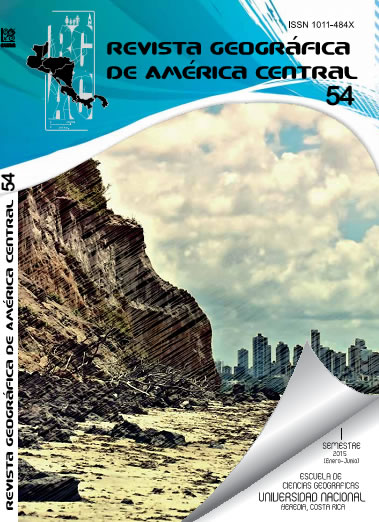IMPLEMENTATION OF GEOSPATIAL WEB VIEWER REGARDING THE WATER RESOURCE FOR THE AQUIFER JACO, PUNTARENAS, GARABITO, 2014
DOI:
https://doi.org/10.15359/rgac.1-54.2Keywords:
Geographic Information Systems, geospatial database, Geoportal, open source software, water resource, Environmental Hydrology LaboratoryAbstract
In order to efficiently share and communicate research regarding water resources, a Geospatial Web Viewer application has been implemented with data related to water resources for the aquifer of Jaco, Garabito, Puntarenas. This information was provided by the Laboratory of Hydrology Environmental (LHA, for its name in Spanish) of the Nacional University (UNA) during 2012 and 2014. The system is based on the importance of storing, managing, and communicating geographic information; this is, they way in which this information should be standardized and interoperable, stored and managed in a database space and posted on the Internet based on Web Mapping. All this with the support of open code programs as a tool for processing the data.References
Anderson, G. y Moreno, R. (October 2003). Building Web-Based Spatial Information Solutions around Open Specifiations and Open Source Software. Transactions in GIS, 7(4), 447- 466. doi:10.1111/1467-9671.00158
Elsmari, R. y Navathe, S. (2007). Fundamentos de bases de datos. (5ª ed.).Madrid, España: Pearson Educación SA.
Gorni, D., Giannotti, M., Brito, P., Knopik, A. y Rodríguez, M. (2007). Sistema de información geográfica para web con informaciones es paciales (geográficas) de output e input para expediciones. A I Jornadas de SIG Libre. Girona: Universitat. Recuperado de http://dugi-doc.udg.edu/bitstream/handle/10256/1233/SistInfoWeb _Com.pdf?sequence=1
Instituto Geográfico Nacional. (1983-1989). Hojas cartográficas Herradura y Tárcoles. Escala 1:50 000. Proyección Cónica Conforme de Lambet. San José: Instituto Geográfico Nacional, Costa Rica.
Instituto Panamericano de Geografía e Historia (IPGH). (2010). Guía de normas. Comité ISO/TC-211. Información geográfica/geomática. Edición en español. México, DF.: Instituto Panamericano de Geografía e Historia.
Instituto Tecnológico de Costa Rica. (2008). Atlas digital de Costa Rica.Escala 1:200 000. Proyección Transversal de Mercator CRTM05.Cartago: Instituto Tecnológico de Costa Rica.
Olaya, V. (2011). Sistemas de información geográfica. España: OSGEO. Recuperado de http://wiki.osgeo.org/wiki/Libro_SIGOpenGeoSuit. (2014). Información general. Recuperado de http://boundlessgeo.com/solutions/opengeo-suite/. Fecha de consulta: 27 de abril de 2014
OpenSourceOrg. (2014). Open Source Iniciative. Recuperado de http://www.opensource.org/
Radilla, F. (2008). Modelado de datos para base de datos espaciales. Caso de estudio: sistemas de información geográfica. Maestro en Ciencias en la Especialidad de Ingeniería Eléctrica. México, DF: Centro de Investigación y de Estudios Avanzados del Instituto Politécnico Nacional, Departamento de Computación.
Sánchez, Y. y Amoros, M. (2012). Gestión del agua urbana mediante Análisis Espacial en los SIG. Ingeniería Hidráulica y Ambiental (RIHA),33(3), 58-71.
Tomlinson, R. (2007). Pensando en el SIG. New York, Estados Unidos: ESRI.
Unidad Ejecutora del Proyecto Regularización Catastral y de Registro.(2007). Cartografía base: línea de costa, curvas de nivel, ríos y carreteras. Escala 1:5000. Proyección Transversal de Mercator CRTM05. San José: Asamblea Legislativa, Costa Rica.
Unidad Ejecutora del Proyecto Regularización Catastral y de Registro.(2007). Ortofotos del área de Jacó. Escala 1:5000. Proyección Transversal de Mercator CRTM05. San José: Asamblea Legislativa, Costa Rica.
Downloads
Published
How to Cite
Issue
Section
License
Proposed policy for journals offering Open Access
Authors publishing their works in the Journal acknowledge and agree to the following terms:
a) Authors retain the copyrights to their works and guarantee the Journal the right to be the first to publish their works, under the Creative Commons License Attribution-NonCommercial-ShareAlike 4.0 International, CC BY-NC-SA 4.0 International (https://creativecommons.org/licenses/by-nc-sa/4.0/deed.es), which allows others to share works upon complying with the acknowledgment of authorship and mention of the Journal as the original publisher of the work.
b) Authors are permitted to separately establish additional agreements for the non-exclusive distribution of the official edition of the work published in the Journal (for example, authors may desire to place the work in an institutional repository or incorporate it into a book that is to published elsewhere) so long they acknowledgment to recognize the Journal as the original publisher. The aforementioned additional agreements must respect the terms of the non-profit character and sharing philosophy of the original license (CC BY-NC-SA 4.0 International, https://creativecommons.org/licenses/by-nc-sa/4.0/deed.es).
c) Authors are encouraged to archive the post-print or editor/PDF version in Open Access repositories.






 REVGEO is licensed under https://creativecommons.org/licenses/by-nc-sa/4.0/deed.es
REVGEO is licensed under https://creativecommons.org/licenses/by-nc-sa/4.0/deed.es
.svg_4.png)

_(1).png)
_(1)_(1)_(1)_1.png)
(2)(1)(1)(1).png)
